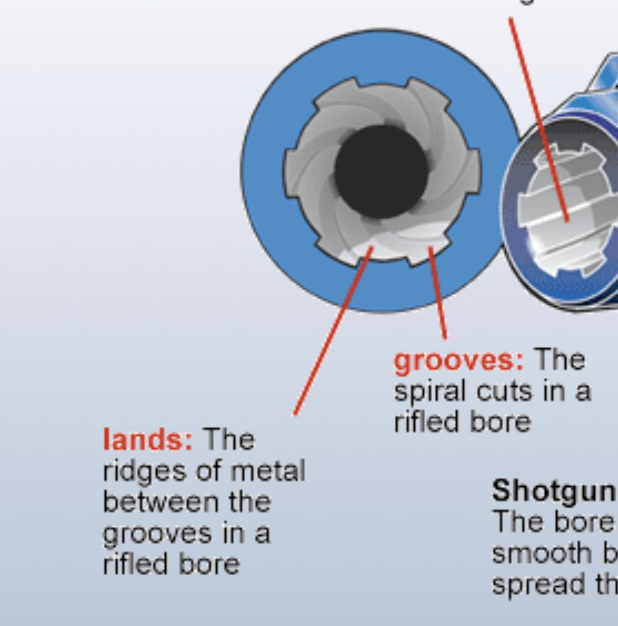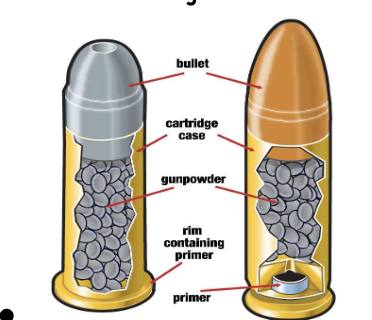Forensics Test - Firearms
1/41
There's no tags or description
Looks like no tags are added yet.
Name | Mastery | Learn | Test | Matching | Spaced |
|---|
No study sessions yet.
42 Terms
Ballastics
The study of guns and bullets
Types of firearms (guns)
Handguns/pistols (revolver and semi-automatic)
Rifles
Shotguns
Machine guns
Air or BB guns
Handgun/pistol characteristics
Held in one hand
Easy to carry and conceal
Not accurate
Limited to the number of bullets it has
Common types: Glock, Smith & Wesson, Colt, Ruger
Revolver
Type of handgun
Has a cylinder that holds 6 bullets arranged to rotate around an axis to be discharged (spinny one)
Reload by hand
Does not eject shell
Shoots 1 cartridge each time when shot
More accurate than semi-automatic
Semi-automatic
Type of handgun
Has empty cartridge
Reloads automatically
Can hold 5-19 rounds (whole thing, cartridge, power, and bullet, not just bullet) in magazine/clip
Rifles
“The long gun”
Long barrel
Shoots more powerful cartridges than handguns, so more accurate and greater range
Shotguns
“The pellets gun, used for hunting and games”
similar to rifles, but shoots a packet of spherical pellets
Inside of barrel, not rifled
Used for:
Hunting birds and other small game
Close quarters combat weapon and defensive weapon
Target shooting sports: skeet, trap, and sporting clays
Machine gun
“Video game gun, military”
Military weapon
Fully automatic, keeps firing when trigger is held back
Fires bullets in quick succession from an ammo belt or magazine
Air or BB guns
Shot/pellets propelled by pressurized air, spring compression or carbon dioxide cartridge
Breech face
Part of the gun that contains the firing mechanism (right behind bullet being fired)
Firing pin
Strikes the primer which ignites the gunpowder (also behind bullet being fired)
Goes through breech face
Magazine
Container that holds bullets under spring pressure to be fed into the gun’s chamber
Chamber
Where the bullet sits before it’s shot
Barrel
Tube part the bullets travel through before being in the air.
Rifled (meaning it has ridges on it that are slightly swirled longways), except for shotguns. Rifled barrel allows bullet to spin and increase its accuracy
Bore
Diameter of a gun barrel
Lands & grooves
Groove: Cut part of rifled barrel
Land: Space between cut grooves

Extractor
Hooked part that pulls the spent casing
Ejector
Throws the spent casing from the gun
Basically the bullet has a casing/shell on it, once it’s fired the shell comes down, there’s a hook that pulls it, the extractor, then it falls out because of the ejector)
4 Components of ammunition
Cartridge, case/shell/casing
Primer, first thing that ignites and starts up the gunpowder
Propellant, the gunpowder
Projectile, the bullet

Handgun vs. Shotgun ammunition parts
Handgun (traditional 4 parts: cartridge, primer, propellent, projectile)
Shotgun: Sort of same idea, has primer and gunpowder propellent. The pellets are held in a tray (called a plastic body, that whole thing gets shot out too?)
What are bullets made out of
Lead, sometimes jacketed with brass, copper or steel
Why is lead a good material for bullets?
Extremely dense (good for inertia)
Soft metal (able to mold and mushroom)
Cheap
Can be jacketed which prevents disfiguration and makes it more resilient
Caliber
Diameter of a bullet
Can be inches or metric
Must correspond to the diameter of the barrel (cos it needs to go through duh)
What is the unit for bullets?
Weight, expressed as grains (British unit)
Cannelures
Groove around the cylindrical part of the bullet
The 2 ridges, allows the cartilage case to grip onto the bullet
Holds it intact until the gun powder can travel
Types of bullets & their properties
Full metal jackets
Jacketed soft point
Jacketed hollow point
Lead round nose
Semi-wad cutter
Wad cutter
Full metal jacket
Resilient, discorouages disfiguration, viewed easily
Jacketed soft point
Can mushroom (disfigure and flatten out)
Jacketed hollow point
Mushrooms, causes more pain
Lead round nose
Simplest, stays intact
Semi-wad cutter + wad cutter
Target practice
Head stamp
On bottom of bullet
Contains manufacture and size
The firing pin can contact the head stamp either around the rim or in the center
Steps for collecting evidence
Number the evidence
Photograph evidence
Document & take notes
Use gloves to collect evidence
Separate sealed envelope for each piece
Types of ballistics evidence that can be collected
Bullets:
Look for missed shots
If embedded into an area, cut out section of area with the bullet in it, don’t just take out the bullet
Cartridge cases
Gun:
Always treat like it like it’s activated
Unload and remove magazine (record how many bullets were in the magazine)
Separately package magazine and gun (in a special box)
Take care of preserve fingerprints or other evidence
Gunshot residue
Measurements and angles
photo and video surveillance
What to examine at the lab with ballistics
Examine to determine
how many shots were fired?
what kind/type of gun - database
if all were shot from same gun? - compare using microscope to find a match
Ways to examine and determine bullet
Think of the activity in class
Weight
Dimensions
Types (full metal jacket, wad cutter, etc.)
Rifling (lands and grooves)
Cannelures (small ridges around top part of bullets, wraps around)
Striation
Individual evidence produced by movement in the gun, cleaning or manufacturing
Cartridge case examination & determination
Head stamp, dimensions, rim or center fire (CLASS)
Unique impressions. Ex. firing pin, magazine, extractor. All parts. of the bullet are unique evidence (INDIVIDUAL)
Gunshot residue
Happens when gasses combust:
Propel bullet
Blow out from ejector port + barrel
Travels 3-5 feet
As the firearm gets closer, the residue concentrations increase
Elements contained in gunshot residue are not water soluble so the residue can stay on clothing
You can burn the clothes to get rid of it
Can be found on shoot, victim if close enough, or bullet hole if close enough
2 Types of tests to analyze gunshot residue
Griess test
Sodium Rhodizonate
Griess test
Performed first, does not interfere with other tests
Detects nitrites (product of combustion)
Results are orange specks
Sodium Rhodizonate
Detects lead
Results are bright pink